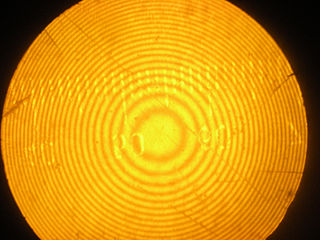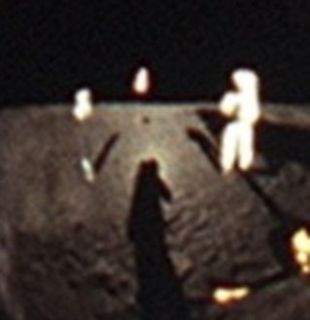This page is based on this
Wikipedia article Text is available under the
CC BY-SA 4.0 license; additional terms may apply.
Images, videos and audio are available under their respective licenses.

Albedo is the measure of the diffuse reflection of solar radiation out of the total solar radiation received by an astronomical body. It is dimensionless and measured on a scale from 0 to 1.

The red-eye effect in photography is the common appearance of red pupils in color photographs of the eyes of humans and several other animals. It occurs when using a photographic flash very close to the camera lens in ambient low light.

Reflection is the change in direction of a wavefront at an interface between two different media so that the wavefront returns into the medium from which it originated. Common examples include the reflection of light, sound and water waves. The law of reflection says that for specular reflection the angle at which the wave is incident on the surface equals the angle at which it is reflected. Mirrors exhibit specular reflection.

Tired light is a class of hypothetical redshift mechanisms that was proposed as an alternative explanation for the redshift-distance relationship. These models have been proposed as alternatives to the models that require metric expansion of space of which the Big Bang and the Steady State cosmologies are the most famous examples. The concept was first proposed in 1929 by Fritz Zwicky, who suggested that if photons lost energy over time through collisions with other particles in a regular way, the more distant objects would appear redder than more nearby ones. Zwicky himself acknowledged that any sort of scattering of light would blur the images of distant objects more than what is seen. Additionally, the surface brightness of galaxies evolving with time, time dilation of cosmological sources, and a thermal spectrum of the cosmic microwave background have been observed — these effects should not be present if the cosmological redshift was due to any tired light scattering mechanism. Despite periodic re-examination of the concept, tired light has not been supported by observational tests and has lately been consigned to consideration only in the fringes of astrophysics.

Moonlight consists of mostly sunlight reflected from the parts of the Moon's surface where the Sun's light strikes.

Heiligenschein is an optical phenomenon in which a bright spot appears around the shadow of the viewer's head. In photogrammetry and remote sensing, it is more commonly known as the hotspot.

Newton's rings is a phenomenon in which an interference pattern is created by the reflection of light between two surfaces—a spherical surface and an adjacent touching flat surface. It is named for Isaac Newton, who investigated the effect in his 1704 "Opticks". When viewed with monochromatic light, Newton's rings appear as a series of concentric, alternating bright and dark rings centered at the point of contact between the two surfaces. When viewed with white light, it forms a concentric ring pattern of rainbow colors, because the different wavelengths of light interfere at different thicknesses of the air layer between the surfaces.

Three-point lighting is a standard method used in visual media such as theatre, video, film, still photography and computer-generated imagery. By using three separate positions, the photographer can illuminate the shot's subject however desired, while also controlling the shading and shadows produced by direct lighting.

Richard Chace Tolman was an American mathematical physicist and physical chemist who was an authority on statistical mechanics. He also made important contributions to theoretical cosmology in the years soon after Einstein's discovery of general relativity. He was a professor of physical chemistry and mathematical physics at the California Institute of Technology (Caltech).

Fill flash is a photographic technique used to brighten deep shadow areas, typically outdoors on sunny days, though the technique is useful any time the background is significantly brighter than the subject of the photograph, particularly in backlit subjects. To use fill flash, the aperture and shutter speed are adjusted to correctly expose the background, and the flash is fired to lighten the foreground.
The Tolman length
measures the extent by which the surface tension of a small liquid drop deviates from its planar value. It is conveniently defined in terms of an expansion in
, with
the equimolar radius of the liquid drop, of the pressure difference across the droplet's surface:

USS Tolman (DD-740/DM-28/MMD-28) was a Robert H. Smith-class destroyer minelayer in the United States Navy. She was named for Commander Charles E. Tolman. As of 2009, no other ship has been named Tolman.

Timothy Lee Tolman is an American former Major League Baseball outfielder.

X-shaped radio galaxies are a class of extragalactic radio source that exhibit two, low-surface-brightness radio lobes oriented at an angle to the active, or high-surface-brightness, lobes. Both sets of lobes pass symmetrically through the center of the elliptical galaxy that is the source of the lobes, giving the radio galaxy an X-shaped morphology as seen on radio maps.

Brenthis daphne, the marbled fritillary, is a butterfly of the family Nymphalidae.

The opposition surge is the brightening of a rough surface, or an object with many particles, when illuminated from directly behind the observer. The term is most widely used in astronomy, where generally it refers to the sudden noticeable increase in the brightness of a celestial body such as a planet, moon, or comet as its phase angle of observation approaches zero. It is so named because the reflected light from the Moon and Mars appear significantly brighter than predicted by simple Lambertian reflectance when at astronomical opposition. Two physical mechanisms have been proposed for this observational phenomenon: shadow hiding and coherent backscatter.
Tryon's Rat Experiment is a psychology experiment conducted by Robert Tryon.














